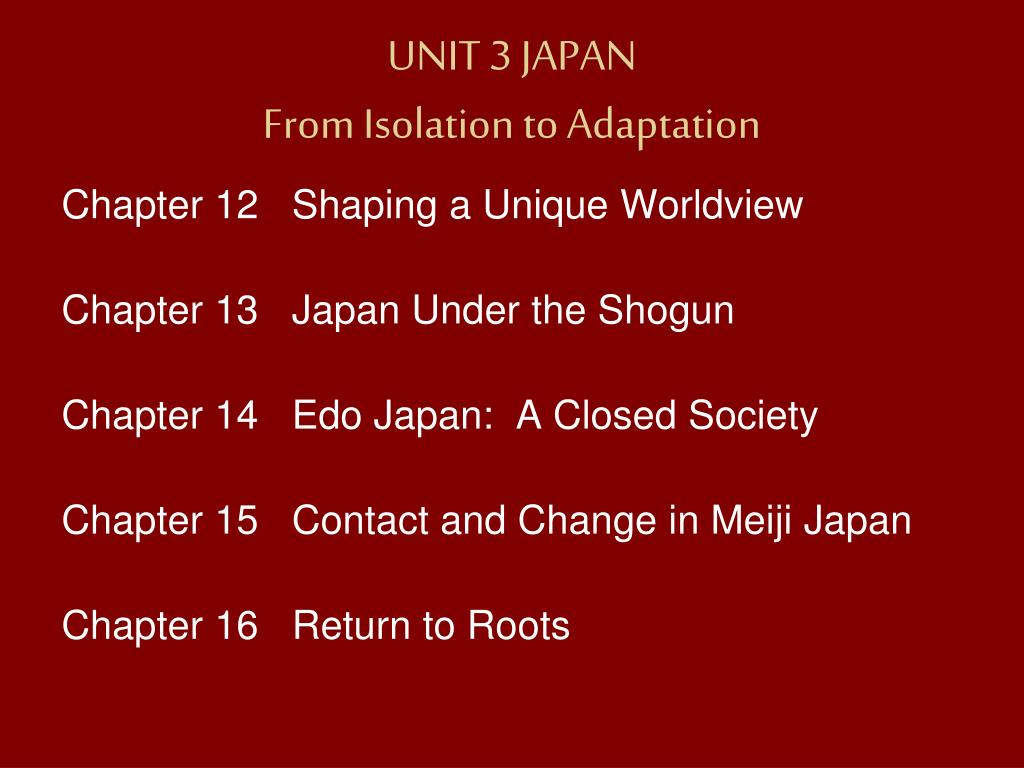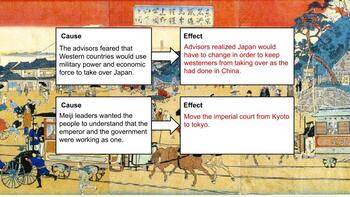Luke Bible Study - Online Lutheran Bible Study Online Lutheran Bible Study This is an in-depth study of the book of Luke based on the Concordia Commentary. This version includes a study guide with questions and answers. Bible Study Questions on the Gospel of Luke Introduction: This workbook was designed for Bible class study, family study, or personal study. The class book is suitable for teens and up. The questions contain minimal human commentary, but instead urge students to study. The “Joy:fully Lutheran” Bible study is based on the 2019 convention theme verse: “See that no one repays anyone evil for evil, but always seek to do good to one another and to everyone. Rejoice always, pray without ceasing, give thanks in all circumstances; for this is the will of God in Christ Jesus” (1 Thess. Luke qindepthonline lutheran bible study commentary.
- Chapter 15 Contact And Change In Meiji Japan
- Chapter 15: Contact And Change In Meiji Japan Language
- Chapter 15: Contact And Change In Meiji Japan City

Chapter 15 Contact And Change In Meiji Japan


The Imperial Diet, Japan’s first modern legislature, was established in 1890 under the 1889 Meiji Constitution, the first modern Constitution enacted in Japan. The Meiji Constitution gave the Emperor a broad range of strong powers. The Imperial Diet consisted of two houses: the House of Peers and the House of Representatives. How Did Japan Decide to Implement Change During the Meiji Period? Japans leaders came to a decision that to keep power they would have to change their ways of life. They changed their government, military, economy, and many other aspects of their life.

Chapter 15: Contact And Change In Meiji Japan Language
“ Technological Leadership and Late Development: Evidence from Meiji Japan, 1868–1912.” Economic History Review 64, no. S1 ( 2011 ): 99 – 116. JAPAN BETWEEN THE WARS 495 1. Steps toward Party Government 496 2. Japan in World Affairs 511 3. Economic Change 528 16. TAISHO¯ CULTURE AND SOCIETY 537 1. Education and Change 537 2. The Law Faculty of Tokyo Imperial University 542 3. Taisho¯ Youth: From “Civilization” to “Culture” 548 4. Free avenged sevenfold mp3 downloads.
Chapter 15: Contact And Change In Meiji Japan City
- Menzel Meskill coined the term “hollow alliance” for the wartime Axis. Johanna Menzel Meskill, Nazi Germany and Imperial Japan: The Hollow Diplomatic Alliance (1966; reprint, New Brunswick—London: Aldine Transactions: 2012). The original title of the book was Hitler and Japan. The Hollow Alliance.Google Scholar
- Akira Iriye, Global and Transnational History: The Past, Present, and Future (Basingstoke: Palgrave Macmillan, 2013), 14.Google Scholar
- Andreas Eckert, “Germany and Africa in the Late Nineteenth and Twentieth Centuries. An Entangled History?” in Comparative and Transnational History. Central European Approaches and New Perspectives, ed. Heinz-Gerhard Haupt and Jürgen Kocka (New York & Oxford: Berghahn Books, 2009), 227.Google Scholar
- Jūrgen Osterhammel, “A ‘Transnational’ History of Society: Continuity or New Departure?” in Comparative and Transnational History Central European Approaches and New Perspectives, ed. Heinz-Gerhard Haupt and Jūrgen Kocka (New York & Oxford: Berghahn Books, 2009), 49;Google Scholar
- Sebastian Conrad, “Double Marginalization: A Plea for a Transnational Perspective,” in Comparative and Transnational History, Central European Approaches and New Perspectives, ed. Heinz-Gerhard Haupt and Jūrgen Kocka (New York & Oxford: Berghahn Books, 2009), 61–63.Google Scholar
- “Introduction,” in Competing Visions of World Order: Global Moments and Movements, 1880s-1930s, ed. Sebastian Conrad and Dominic Sachsenmaier (New York: Palgrave Macmillan, 2012), 3. Dirk Hoerder, “Losing National Identity or Gaining Transcultural Competence,” in Comparative and Transnational History. Central European Approaches and New Perspectives, ed. Heinz-Gerhard Haupt and Jūrgen Kocka (New York & Oxford: Berghahn Books, 2009), 253.Google Scholar
- Russell A. Berman, Enlightenment or Empire: Colonial Discourse in German Culture (Lincoln: University of Nebraska Press, 1998);Google Scholar
- George Steinmetz, The Devil’s Handwriting: Precoloniality and the German Colonial State in Qingdao, Samoa, and Southwest Africa (Chicago: The University of Chicago Press, 2007);CrossRefGoogle Scholar
- Geoff Eley and Bradley Naranch, eds., German Cultures of Colonialism (Durham, NC: Duke University Press, 2014).Google Scholar
- Todd Kontje, German Orientalism (Ann Arbor: The University of Michigan Press, 2004);Google Scholar
- Nina Berman, German Literature on the Middle East: Discourses and Practices, 1000–1989 (Ann Arbor: University of Mchigan Press, 2011).Google Scholar
- Suzanne Marchand, German Orientalism (Cambridge: The German Historical Institute/Cambridge University Press, 2009).Google Scholar
- Lee M. Roberts, ed., Germany and the Imagined East (Newcastle, UK: Cambridge Scholars Publishing, 2005 (2nd ed., 2009);Google Scholar
- Veronika Fuechtner and Mary Rhiel, eds., Imagining Germany Imagining Asia: Essays in Asian-German Studies (Rochester, NY: Camden House, 2013);Google Scholar
- Qinna Shen and Martin Rosenstock, eds., Beyond Alterity: German Encounters with Modern East Asia (New York and Oxford: Berghahn, 2014);Google Scholar
- Joanne Myang Cho and David M. Crowe, eds., China and Germany: Transnational Encounters since the Eighteenth Century (New York: Palgrave Macmillan, 2014).Google Scholar
- Akira Iriye, Global and Transnational History (Basingstoke: Palgrave Macmillan, 2012).CrossRefGoogle Scholar
- Akira Iriye and Pierre-Yves Saunier, eds., The Palgrave Dictionary of Transnational History. From the mid-19th to the Present Day (Basingstoke: Palgrave Macmillan, 2009).Google Scholar
- Monica Juneja and Margrit Pernau, “Lost in Translation? Transcending Boundaries,” in Comparative and Transnational History. Central European Approaches and New Perspectives, ed. Heinz-Gerhard Haupt and Jūrgen Kocka (New York & Oxford: Berghahn Books, 2009), 107, 110.Google Scholar
- Heinz-Gerhard Haupt and Jürgen Kocka, “Introduction,” Comparative and Transnational History. Central European Approaches and New Perspectives, ed. Heinz-Gerhard Haupt and Jūrgen Kocka (New York & Oxford: Berghahn Books, 2009), 2.Google Scholar
- Ian Buruma, Wages of Guilt: Memories of War in Germany and Japan (London: Vintage, 1995);Google Scholar
- Sebastian Conrad, Auf der Suche nach der verlorenen Nation Geschichtsschreibung in Westdeutschland und Japan, 1945–1960 (Gōttingen: Vandenhoeck & Ruprecht, 1999);Google Scholar
- Anthony C. Grayling, Among the Dead Cities: The History and Moral Legacy of the WWII Bombing of Civilians in Germany and Japan (New York: Walker & Co., 2007);Google Scholar
- Masako Shibata, Japan and Germany under the U.S. Occupation: A Comparative Analysis of Post-War Education Reform (Lanham, MD: Lexington Books, 2008);Google Scholar
- Sebastian Conrad, The Quest for the Lost Nation: Writing History in Germany and Japan in the American Century, trans. Alan Nothnagle (Berkeley: University of California Press, 2010);Google Scholar
- Julian Dierkes, Postwar History Education in Japan and the Germanys: Guilty Lessons (London and New York: Routledge, 2010);Google Scholar
- Alexandra Sakaki, Japan and Germany as Regional Actors: Evaluating Change and Continuity after the Cold War (London and New York: Routledge, 2012).Google Scholar
- Frank W. Iklé, German-Japanese Relations, 1936–1940 (1956; reprint, Whitefish, MT: Literary Licensing, LLC, 2012);Google Scholar
- Ernst L. Presseisen, Germany and Japan—A Study in Totalitarian Diplomacy, 1933–1941 (The Hague: Martinus Nijhoff, 1958, 2nd ed. 1969);Google Scholar
- Theo Sommer, Deutschland und Japan zwischen den Mächten, 1935–1940 (Tūbingen: JCB Mohr, 1962);Google Scholar
- Myake Masaki, “Die Achse Berlin-Rom-Tokio im Spiegel der japanischen Quellen,” in Mitteilungen des ōsterreichischen Staatsarchivs, 21 (1968), 408–445;Google Scholar
- Menzel Meskill, Nazi Germany and Imperial Japan; Bernd Martin, Deutschland und Japan im Zweiten Weltkrieg 1940–1945, Vom Angriff auf Pearl Harbor bis zu deutschen Kapitulation (1969; reprint, Hamburg: Niko, 2001);Google Scholar
- Myake Masaki, Nichi-Doku-I sangokudōmei no kenkyū [A Study on the Tripartite Alliance Berlin-Rome-Tokyo] (Tokyo: Nansosha, 1975);Google Scholar
- Masako Shibata, Japan and Germany under the U.S. Occupation: A Comparative Analysis of Postwar Education Reform (Lanham: Lexington, 2005).Google Scholar
- Representative examples include the following: Hans-Joachim Krug, Yoichi Hirama and Berthold J. Sander-Nagashima, Reluctant Allies. German Japanese Naval Relations in World War II (Annapolis, MD: United States Naval Institute, 2001);Google Scholar
- Nils-John Jōrgensen, Culture and Power in Germany and Japan. The Spirit of Renewal (London: Global Oriental, 2006);Google Scholar
- Julian Dierkes, Postwar History Education in Japan and the Germanys: Guilty Lessons (London and New York: Routledge, 2010); Lee M. Roberts, Literary Nationalism in German and Japanese Germanistik, Berkeley Insights in Linguistics and Semiotics, vol. 78 (New York: Peter Lang, 2010);Google Scholar
- John W. M. Chapman, Ultranationalism in German-Japanese Relations, 1930–1945 (Lanham: Global Oriental, 2011);CrossRefGoogle Scholar
- Sebastian Dobson and Sven Saaler, Unter den Augen des Preußen-Adlers: Lithographien, Zeichnungen und Photographien der Teilnehmer der Eulenburg-Mission in Japan 1860–1861 / Under Eagle Eyes: Lithographs, Drawings & Photographs from the Prussian Expedition to Japan, 1860–61 (Munich: Iudicium, 2011);Google Scholar
- Christian W. Spang, Karl Haushofer und Japan. Die Rezeption seiner geopolitischen Theorien in der deutschen und japanischen Politik (Munich: Iudicium, 2013).Google Scholar
- Inge Hoppner and Sekikawa Fujiko, Japanisch-Deutsches Zentrum Berlin and Japanisch Deutsche Gesellschaft Tokyo, eds., Hrückenbauer: Pioniere des japanisch-deutschen Kulturaustausches (Munich: Iudicium, 2005);Google Scholar
- Mark Feiton, Yanagi: The Secret Underwater Trade between Germany and Japan 1942–1945 (Barnsley: Leo Cooper, 2005);Google Scholar
- Peter Pantzer and Sven Saaler, Japanische Impressionen eines Kaiserlichen Gesandten. Karl von Eisendecher im Japan der Meiji-Zeit (Munich: Iudicium, 2007);Google Scholar
- Curt-Engelhorn-Stiftung fūr die Reiss-Engelhorn-Museen and Verband der Deutsch-Japanischen Gesellschaften, eds., Eerne Gefährten. 150 Jahre deutsch-japanische Beziehungen (Mannheim: Schnell und Steiner, 2011);Google Scholar
- Ruprecht Vondran, ed., Gelebte Partnerschaft—Deutschland und Japan (Duesseldorf: Droste Verlag, 2014).Google Scholar
- An up-to-date overview of the recent publications in the field of German-Japanese relations is offered in Christian W. Spang, “Japanese-German Relations Revisited. An Outline from Meiji to Early Shōwa Period,” in Tōyō Kenkyū (The Studies of Asia and Africa) 195 (2015), 93–133.Google Scholar
- Christian W. Spang and Rolf-Harald Wippich, eds., Japanese-German Relations, 1895–1945: War, Diplomacy of Public Opinion (New York: Routledge, 2006, 2nd ed., 2008).Google Scholar
- Kudō Akira, Tajima Nobuo, and Erich Pauer, eds., Japan and Germany: Two Late Comers on the World Stage, 1890–1945 (Folkestone, UK: Global Oriental. 2009).Google Scholar
- Two of the three editors are specialists in economic contacts between Germany and Japan. Cf. Kudō Akira, Japanese-German Business Relations: Co-operation and Rivalry in the Interwar Period (Abingdon & New York: Taylor & Francis, 1998),Google Scholar
- and Erich Pauer, ed., Japan’s War Economy (London and New York: Routledge, 1999).Google Scholar
